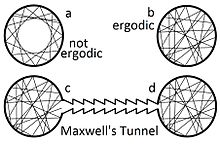22:
308:, the ergodic hypothesis corresponds to the assumption that individuals are representative of groups, and vice-versa, that group averages can adequately characterize what might be seen in an individual. This appears to not be the case: group level data often gives a poor indication of individual level variation, as individual standard deviations (SDs) tend to be almost eight times larger than group level SDs of the same people. Subsequently a third of the individual observations falls outside a 99.9% confidence interval of group level data.
38:
188:
the system preferentially adopts a non-zero magnetisation even though the ergodic hypothesis would imply that no net magnetisation should exist by virtue of the system exploring all states whose time-averaged magnetisation should be zero. The fact that macroscopic systems often violate the literal
267:
has argued that a very important part of empirical reality in finance and investment is non-ergodic. An even statistical distribution of probabilities, where the system returns to every possible state an infinite number of times, is simply not the case we observe in situations where "absorbing
200:
show an even more complicated form of ergodicity breaking where the properties of the thermodynamic equilibrium state seen in practice are much more difficult to predict purely by symmetry arguments. Also conventional glasses (e.g. window glasses) violate ergodicity in a complicated manner. In
248:
The situations modeled by these theories can be useful. But often they are only useful during much, but not all, of any particular time period under study. They can therefore miss some of the largest deviations from the standard model, such as
130:
are the same. This assumption—that it is as good to simulate a system over a long time as it is to make many independent realizations of the same system—is not always correct. (See, for example, the
578:
91:, the local density of microstates following a particle path through phase space is constant as viewed by an observer moving with the ensemble (i.e., the
296:
are no longer possible."—will be non-ergodic. All traditional models based on standard probabilistic statistics break down in these extreme situations.
288:, "anything that prevents people with skin in the game from emerging from it, and to which the system will invariably tend. Let us call these situations
201:
practice this means that on sufficiently short time scales (e.g. those of parts of seconds, minutes, or a few hours) the systems may behave as
131:
84:
46:
458:"A manifesto on psychology as idiographic science: Bringing the person back into scientific psychology, this time forever"
41:
This device can trap fruit flies, but if it trapped atoms when placed in gas that already uniformly fills the available
388:
The introduction of the practical aspect of ergodicity breaking by introducing a "non-ergodicity time scale" is due to
74:
379:('Ergoden' on p.89 in the 1923 reprint.) It was used to prove equipartition of energy in the kinetic theory of gases.
96:
292:, as the entity cannot emerge from the condition. The central problem is that if there is a possibility of ruin,
573:
338:
190:
77:
with the same energy is proportional to the volume of this region, i.e., that all accessible microstates are
583:
272:
is seen. The death of an individual, or total loss of everything, or the devolution or dismemberment of a
137:
Assumption of the ergodic hypothesis allows proof that certain types of perpetual motion machines of the
293:
172:
In macroscopic systems, the timescales over which a system can truly explore the entirety of its own
205:, i.e. with a positive shear modulus, but on extremely long scales, e.g. over millennia or eons, as
238:
138:
50:
563:
230:
333:
264:
115:
511:
399:
234:
127:
111:
8:
568:
176:
can be sufficiently large that the thermodynamic equilibrium state exhibits some form of
92:
30:
18:
Statistical mechanics hypothesis that all microstates are equiprobable for a given energy
515:
403:
364:
534:
499:
477:
157:
88:
69:
says that, over long periods of time, the time spent by a system in some region of the
21:
539:
500:"Lack of group-to-individual generalizability is a threat to human subjects research"
481:
370:
185:
229:
assume ergodicity, explicitly or implicitly. The ergodic hypothesis is prevalent in
529:
519:
469:
407:
250:
438:
325:, a branch of mathematics concerned with a more general formulation of ergodicity
317:
281:
473:
322:
305:
242:
161:
62:
411:
557:
457:
277:
258:
181:
524:
374:
543:
343:
273:
78:
103:
initially, they will remain so at all times. But
Liouville's theorem does
254:
173:
100:
70:
42:
328:
226:
197:
145:
284:
matters. A path where an individual, firm or country hits a "stop"—an
107:
imply that the ergodic hypothesis holds for all
Hamiltonian systems.
26:
416:. Also related to these time-scale phenomena are the properties of
149:
280:
that accompanied it, are all absorbing states. Thus, in finance,
222:
153:
119:
58:
37:
417:
180:. A common example is that of spontaneous magnetisation in
123:
144:
Systems that are ergodic are said to have the property of
25:
The question of ergodicity in a perfectly collisionless
299:
261:
in the banking system that occur only infrequently.
555:
216:
189:form of the ergodic hypothesis is an example of
493:
491:
110:The ergodic hypothesis is often assumed in the
362:Originally due to L. Boltzmann. See part 2 of
196:However, complex disordered systems such as a
579:Philosophy of thermal and statistical physics
449:
488:
445:, Cambridge University Press, pp. 46–66
160:are ergodic. Ergodic systems are studied in
390:Palmer, R. G. (1982). "Broken ergodicity".
533:
523:
455:
36:
20:
95:is zero). Thus, if the microstates are
556:
497:
389:
209:, or with two or more time scales and
436:
421:
300:Ergodic hypothesis in social science
118:. The analyst would assume that the
268:states" are reached, a state where
132:Fermi–Pasta–Ulam–Tsingou experiment
13:
14:
595:
439:"Probability, Risk, and Extremes"
424:Dynamics of Glass Forming Liquids
420:and the Mode-Coupling theory of
167:
437:Taleb, Nassim Nicholas (2019),
430:
382:
369:. Leipzig: J. A. Barth. 1898.
356:
148:; a broad range of systems in
1:
349:
217:Ergodic hypothesis in finance
191:spontaneous symmetry breaking
441:, in Needham, Duncan (ed.),
122:of a process parameter over
81:over a long period of time.
51:second law of thermodynamics
7:
366:Vorlesungen über Gastheorie
339:Poincaré recurrence theorem
311:
184:systems, whereby below the
10:
600:
474:10.1207/s15366359mea0204_1
93:convective time derivative
412:10.1080/00018738200101438
126:and the average over the
525:10.1073/pnas.1711978115
456:Molenaar, P.C. (2004).
231:modern portfolio theory
54:
34:
574:Statistical mechanics
498:Fisher, A.J. (2018).
426:. Oxford Univ. Press.
294:cost benefit analyses
265:Nassim Nicholas Taleb
116:computational physics
97:uniformly distributed
40:
24:
235:discounted cash flow
128:statistical ensemble
112:statistical analysis
87:states that, for a
31:specular reflections
584:Concepts in physics
516:2018PNAS..115E6106F
404:1982AdPhy..31..669P
392:Advances in Physics
334:Loschmidt's paradox
241:models that infuse
239:aggregate indicator
178:ergodicity breaking
85:Liouville's theorem
47:Liouville's theorem
422:Götze, W. (2008).
237:(DCF) models, and
89:Hamiltonian system
67:ergodic hypothesis
55:
53:would be violated.
35:
510:(27): 6106–6115.
286:absorbing barrier
186:Curie temperature
591:
548:
547:
537:
527:
495:
486:
485:
453:
447:
446:
434:
428:
427:
415:
386:
380:
378:
360:
251:financial crises
245:, among others.
141:are impossible.
599:
598:
594:
593:
592:
590:
589:
588:
554:
553:
552:
551:
496:
489:
454:
450:
435:
431:
387:
383:
363:
361:
357:
352:
318:Ergodic process
314:
306:social sciences
302:
282:path dependence
221:Models used in
219:
170:
19:
12:
11:
5:
597:
587:
586:
581:
576:
571:
566:
564:Ergodic theory
550:
549:
487:
468:(4): 201–218.
448:
429:
381:
354:
353:
351:
348:
347:
346:
341:
336:
331:
326:
323:Ergodic theory
320:
313:
310:
301:
298:
243:macroeconomics
218:
215:
169:
166:
162:ergodic theory
63:thermodynamics
17:
9:
6:
4:
3:
2:
596:
585:
582:
580:
577:
575:
572:
570:
567:
565:
562:
561:
559:
545:
541:
536:
531:
526:
521:
517:
513:
509:
505:
501:
494:
492:
483:
479:
475:
471:
467:
463:
459:
452:
444:
440:
433:
425:
419:
413:
409:
405:
401:
397:
393:
385:
376:
372:
368:
367:
359:
355:
345:
342:
340:
337:
335:
332:
330:
327:
324:
321:
319:
316:
315:
309:
307:
297:
295:
291:
287:
283:
279:
275:
271:
266:
262:
260:
259:systemic risk
256:
252:
246:
244:
240:
236:
232:
228:
224:
214:
212:
208:
204:
199:
194:
192:
187:
183:
182:ferromagnetic
179:
175:
168:Phenomenology
165:
163:
159:
155:
151:
147:
142:
140:
135:
133:
129:
125:
121:
117:
113:
108:
106:
102:
98:
94:
90:
86:
82:
80:
76:
72:
68:
64:
60:
52:
48:
44:
39:
32:
28:
23:
16:
507:
503:
465:
461:
451:
442:
432:
423:
395:
391:
384:
365:
358:
344:Lindy effect
303:
289:
285:
278:legal regime
274:nation state
269:
263:
247:
220:
213:in between.
210:
206:
202:
195:
177:
171:
143:
136:
109:
104:
83:
79:equiprobable
66:
56:
45:, then both
15:
462:Measurement
255:debt crises
174:phase space
158:probability
139:second kind
101:phase space
75:microstates
71:phase space
43:phase space
569:Hypotheses
558:Categories
398:(6): 669.
350:References
329:Ergodicity
227:investment
198:spin glass
146:ergodicity
134:of 1953.)
482:145323330
27:ideal gas
544:29915059
443:Extremes
375:01712811
312:See also
276:and the
211:plateaux
150:geometry
49:and the
535:6142277
512:Bibcode
400:Bibcode
304:In the
223:finance
207:liquids
154:physics
120:average
59:physics
542:
532:
480:
418:ageing
373:
203:solids
156:, and
65:, the
478:S2CID
29:with
540:PMID
504:PNAS
371:OCLC
290:ruin
270:ruin
257:and
225:and
124:time
61:and
530:PMC
520:doi
508:115
470:doi
408:doi
114:of
105:not
99:in
73:of
57:In
560::
538:.
528:.
518:.
506:.
502:.
490:^
476:.
464:.
460:.
406:.
396:31
394:.
253:,
233:,
193:.
164:.
152:,
546:.
522::
514::
484:.
472::
466:2
414:.
410::
402::
377:.
33:.
Text is available under the Creative Commons Attribution-ShareAlike License. Additional terms may apply.

